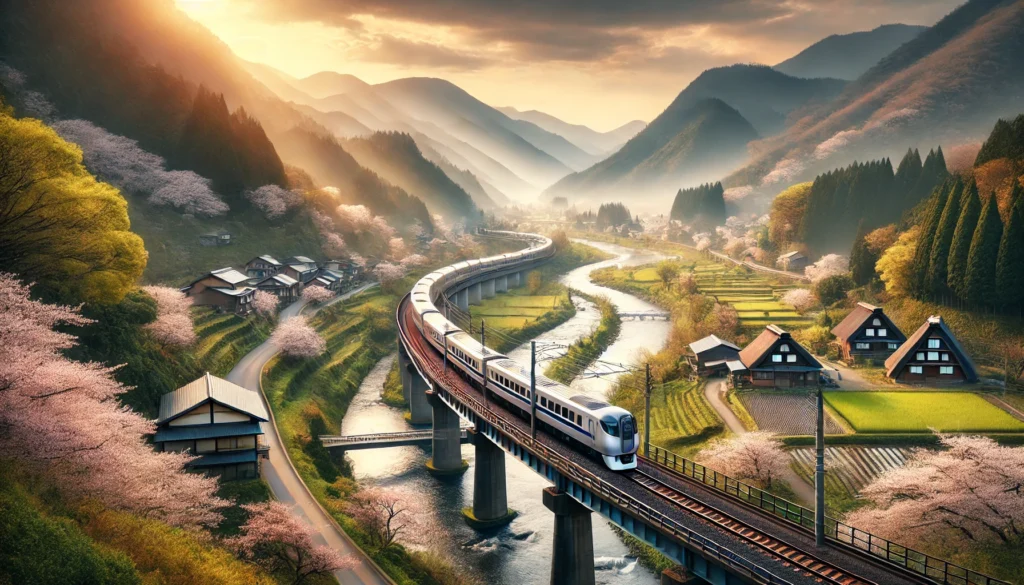Table of Contents
Introduction to Japan’s Train System
Japan boasts one of the most extensive and efficient train systems in the world, serving as a vital mode of transportation for both locals and travelers. The intricate network spans the entire archipelago, connecting major cities, suburban areas, and even remote regions. An impressive range of services caters to diverse needs, ensuring convenience and accessibility. Among the various types of trains, the Shinkansen, or bullet trains, stand out as the epitome of speed and comfort, making them a preferred choice for many travelers.
The Shinkansen, operational since 1964, offers sleek and speedy journeys, drastically reducing travel times between cities like Tokyo, Osaka, and Kyoto. These high-speed trains operate at speeds up to 300 kilometers per hour, allowing passengers to glide effortlessly through the picturesque landscapes of Japan. The experience is enhanced by on-board amenities, including comfortable seating, onboard dining options, and impeccable cleanliness, reflecting the Japanese ethos of hospitality.
In addition to the Shinkansen, Japan’s rail network comprises local trains that connect urban and suburban areas. These trains tend to be slower but are essential for daily commutes and regional travel. They provide access to local attractions, cultural landmarks, and hidden gems, allowing travelers to immerse themselves in Japanese culture and scenery. Moreover, scenic train journeys, such as the famous Limited Express routes and picturesque local trains, offer breathtaking views of mountains, rivers, and coastlines, transforming travel into a visually stunning experience.
Japan’s train system, therefore, serves not merely as a means of transportation, but as a gateway to explore the country’s natural beauty, history, and culture. Whether one opts for the speed of the Shinkansen or the charm of local trains, the journey promises to be as memorable as the destination itself.

Why Train Travel is Ideal for Exploring Japan
Traveling by train in Japan offers a unique and enriching experience, allowing visitors to immerse themselves in the country’s diverse landscapes and culture. One of the primary advantages of train travel is the convenience it provides. Japan boasts an extensive rail network, including the famous Shinkansen, or bullet trains, that connect major cities with remarkable speed. This connectivity makes it easy for travelers to plan their journeys without the hassle of navigating complex transportation systems. With just one ticket, passengers can traverse vast distances while enjoying panoramic views of the countryside.
Punctuality is another hallmark of Japanese trains. The railway system prides itself on being on time, ensuring that travelers can rely on schedules and embark on their adventures without unnecessary delays. This level of dependability not only enhances the travel experience but also helps in planning itineraries more efficiently. Imagine effortlessly transitioning from bustling urban centers to serene rural landscapes, all while staying on schedule.
The comfort offered by Japanese trains is also noteworthy. With spacious seating, clean facilities, and amenities such as onboard dining services, passengers can relax and enjoy their journey. Unlike air travel, where security checks and boarding can be tedious, train travel allows for a smoother process, enabling travelers to board their train minutes before departure.
Moreover, train travel in Japan grants access to areas that may otherwise be overlooked. Many rural destinations are further removed from airports, making train travel the ideal mode of transport for exploring hidden gems nestled in the countryside. Scenic routes, such as the ones that pass through picturesque mountains, rice paddies, and coastal views, provide a dramatic backdrop that enriches any journey. In summary, train travel in Japan combines convenience, punctuality, comfort, and scenic beauty, making it an exceptional way to discover the country’s enchanting landscapes and vibrant culture.
The Best Scenic Train Routes in Japan
Japan’s railway system is renowned not just for its punctuality and efficiency but also for the breathtaking views it offers travelers. Among the best scenic train routes in Japan are the Kurobe Gorge Railway, Limited Express Tanigaw, Gono Line, and the luxury Shiki-Shima train experience.
The Kurobe Gorge Railway is one of the most stunning journeys, spanning approximately 20 kilometers through the mountainous terrain of Toyama Prefecture. As the train navigates the steep cliffs and tunnels, passengers are treated to unparalleled views of deep gorges, cascading waterfalls, and vibrant autumn foliage. The experience is especially magical during the cherry blossom and fall seasons when visitors can witness the landscape transform into a canvas of colors.
Next, the Limited Express Tanigaw connects Tokyo to the scenic Niigata Prefecture. This route is notable for its stunning vistas of the mountains and rivers, particularly along the stretch through the scenic Jōetsu region. Travelers can marvel at the sight of Mount Naeba and the beautiful Tanigawadake range, which are especially striking in winter when they are blanketed in snow.
The Gono Line is another gem, stretching along the coastline of the Sea of Japan from Akita to Aomori. This picturesque route offers panoramic views of the ocean, rugged cliffs, and traditional villages. The Gono Line is particularly famous for its breathtaking coastal scenery and the historical sites that dot the landscape, including the iconic Senjō-jiki and the quaint town of Kanchō.
Finally, the luxurious Shiki-Shima train experience provides an opulent way to explore the beautiful landscapes of Japan. Offering gourmet meals and elegant interiors, this train travels through the picturesque regions of Tohoku and the Japanese Alps. The journey highlights the natural beauty of Japan combined with cultural insights, making it a unique experience for all passengers.
Top Tips for Riding the Train in Japan
Traveling by train in Japan offers a unique glimpse into the country’s scenic landscapes and vibrant culture. To maximize your experience, it is crucial to be well-prepared. One of the first steps is to consider purchasing a Japan Rail Pass (JR Pass). This pass allows unlimited travel on most trains across the nation for a limited period, making it a cost-effective option for tourists. Ensure to buy your JR Pass before arriving in Japan, as it is generally cheaper to purchase it overseas.
Understanding the train schedule is another vital aspect of navigating Japan’s extensive rail network. Various apps, such as hyperdia.com, can assist you in planning your journey by providing real-time information on train schedules, transfer times, and platforms. Remember that punctuality is a hallmark of Japanese trains, so arrive at the station a few minutes early to avoid any last-minute rush. Additionally, check for any seasonal or holiday schedules, as these may affect train frequency.
When it comes to seating, familiarizing yourself with the reservation system is beneficial. While some trains offer non-reserved seats, popular routes can fill up quickly, especially during peak travel seasons. For peace of mind, consider securing a reserved seat when booking your tickets. Moreover, etiquette on public transportation in Japan is paramount. It is customary to maintain a quiet demeanor, keep your phone on silent mode, and save conversations for outside the train.
As for language, while many train signs are bilingual, it’s helpful to learn some basic Japanese phrases. Common terms that can enhance your experience include “Eki” (station) and “Norikae” (transfer). Language resources like translation apps can also bridge the gap for non-Japanese speakers. By following these tips, you will be well-equipped to enjoy your scenic train journey through Japan.
Seasonal Beauty: Traveling by Train through Japan’s Changing Landscapes
Traveling by train in Japan offers a unique vantage point to experience the country’s stunning landscapes, particularly as the seasons shift. Each time of year presents a different aesthetic, transforming the view outside the train windows into a vibrant tableau of nature’s artistry. One of the most celebrated seasons is spring, when cherry blossoms begin to bloom. On various train routes, passengers can enjoy picturesque scenes of sakura trees lining the tracks, their delicate pink petals creating a romantic atmosphere that enchants travelers. Notably, special train services, such as the ‘Sakura Trains,’ operate during this period, catering specifically to those wishing to revel in the beauty of the blooms.
As spring gives way to summer, the greenery transforms into a lush and vibrant palette of shades. The countryside bursts into life with rice paddies, which reflect the blue skies above. The famous Shiki-Shima train offers a luxurious journey through the rich landscapes of summer, allowing travelers to experience the contrast between the serene waters and the verdant fields. Many trains also provide unique amenities that enhance the journey, including meals prepared from local seasonal produce, connecting passengers to the region’s culture.
Autumn introduces a spectacular display of vibrant foliage, with rich reds, oranges, and yellows. The famous Red Route, which stretches through mountainous areas, is particularly captivating during this season. Travelers can witness the contrast of colorful leaves against the backdrop of the crisp blue sky. Some trains even offer special viewing cars specifically designed for capturing the kaleidoscope of colors. In winter, Japan’s landscapes transform yet again, blanketed in serene snowscapes that can be admired from the comfort of a train seat. The joy of seeing snow-covered mountains and tranquil forests makes for an unforgettable experience. Seasonal trains, such as the ‘Snow Train,’ often provide warm drinks and cozy blankets, enhancing the winter travel experience.
Cultural Experiences Awaiting You
Traveling by train in Japan not only offers stunning landscapes but also an opportunity to immerse oneself in the rich cultural heritage of this remarkable nation. Along many scenic rail routes, travelers can explore famous temples, witness local festivals, and experience traditional villages that showcase Japan’s history and artistry. From the picturesque Arashiyama area accessible via the Sagano Scenic Railway to the serene temples nestled in the mountains of Nikko, each stop provides unique insights into Japan’s spiritual and cultural legacy.
Temples are often the highlights of many journeys, with notable sites such as the Kinkaku-ji, or Golden Pavilion, in Kyoto. This Zen temple is surrounded by beautiful gardens and reflects an essence of tranquility and harmony, making it a perfect cultural pitstop for train travelers. Similarly, the grand Toshogu Shrine in Nikko is renowned for its intricate carvings and rich historical significance, being the final resting place of Tokugawa Ieyasu, the founder of the Tokugawa shogunate.
In addition to temples, local festivals add vibrant color and energy to the cultural stops along the scenic train routes. For instance, the Takayama Matsuri, one of Japan’s most beautiful festivals, occurs biannually in spring and autumn. Travelers can experience the magnificent floats and traditional costumes, providing an unforgettable glimpse into local customs and communal spirit. Culinary specialties also play a significant role in cultural exploration. Train passengers might indulge in regional delicacies such as Hida beef or the delicate flavors of seafood from coastal areas, connecting gastronomic experiences with the local culture.
All in all, these cultural experiences are integral to enhancing the scenic travel experience in Japan. They allow travelers to appreciate not only the visually stunning landscapes but also the deep-rooted traditions and customs that continue to thrive throughout the country.
Rail Pass Options for Travelers
Japan offers an array of rail pass options designed to enhance the travel experience while maximizing savings for both domestic and international visitors. The most recognized option is the Japan Rail Pass, which provides unlimited travel on JR trains across the country for a fixed number of days. This pass is particularly beneficial for tourists planning to explore multiple cities, as it covers major routes including the Shinkansen, or bullet trains, providing swift and convenient travel. International travelers must obtain the JR Pass before arriving in Japan to take advantage of its benefits.
In addition to the Japan Rail Pass, various regional passes are available, each tailored for specific areas. For instance, the Kansai Area Pass is ideal for those exploring regions such as Kyoto, Osaka, and Nara. Similarly, the Hokkaido Rail Pass offers unlimited rides across Hokkaido’s expansive rail network, connecting travelers to the stunning landscapes and attractions the northern island has to offer. These regional options enable travelers to focus their time and budget on particular areas, making them a practical choice for those with a defined itinerary.
Moreover, special discounts may apply to some routes, particularly for popular tourist destinations. For example, certain limited express trains provide discount tickets, which can be purchased directly from ticket offices or through vending machines at stations. To maximize savings, travelers should consider reserving seats in advance, especially during peak travel seasons, when prices may rise due to demand.
Overall, understanding the various rail pass options and strategically selecting the one that aligns with your travel plans can significantly enhance the journey across Japan. Leveraging these passes not only makes travel more efficient but also allows travelers to immerse themselves in the scenic beauty and cultural richness of this remarkable country.
Engaging with Locals During Your Train Journey
Traveling by train in Japan offers a unique opportunity to engage with locals and participate in cultural exchange. The slow-paced nature of train travel allows passengers to not only take in the beautiful scenery but also interact with fellow travelers and residents along the way. One of the best aspects of train journeys in Japan is the chance to share stories, traditions, and experiences with others.
To foster meaningful conversations with fellow passengers, it is essential to approach interactions with respect and curiosity. Simple greetings in Japanese, such as “Konnichiwa” (Hello) or “Arigatou” (Thank you), can break the ice and display goodwill. When seated next to a local, initiating light-hearted conversations about the scenery, local customs, or regional cuisines can lead to fascinating exchanges. Remember to listen actively and show genuine interest in their responses, as listening is just as crucial as speaking in cultivating connections.
Moreover, taking part in onboard activities or local events can enhance the interaction experience. Many trains offer themed rides or have programs featuring traditional performances, cooking classes, or food tastings. Participating in these activities not only deepens the appreciation for Japanese culture but also provides a relaxed setting to meet other passengers and locals who share similar interests.
Additionally, stations and stops along popular train routes often host community events, exhibitions, or local markets showcasing regional products. Take advantage of layovers to explore these opportunities. Engaging with local artisans or sampling regional delicacies can create lasting memories and friendships, enriching your travel experience. By embracing these chances for interaction, train journeys transform into cultural adventures that go beyond just reaching a destination.
Conclusion: Embrace the Journey
Traveling through Japan by train presents a unique and enriching way to experience the country’s unparalleled beauty and cultural depth. The scenic routes, ranging from the majestic views of Mount Fuji to the serene coastlines of the Noto Peninsula, showcase Japan’s diverse landscapes. Trains provide not only a means of transport but also a window into the heart of Japan, allowing travelers to appreciate the serene beauty that unfolds along the way.
As you journey through Japan, each train ride offers more than just a trip from point A to B. It unfolds a narrative steeped in the rich history of the nation, revealing picturesque towns, lush greenery, and breathtaking vistas that can easily be missed when traveling by other means. The country’s rail network is known for its punctuality and comfort, making it an ideal choice for both seasoned travelers and those visiting for the first time.
Moreover, the cultural experiences accessible by train are profound. Visitors can indulge in the local gastronomy offered at various stops, witness seasonal changes, and even engage with the friendly locals who might share their stories or recommendations. The gradual pace of train travel allows for reflection and appreciation of the surroundings, enhancing the overall journey. From the vibrant cityscapes to tranquil rural areas, trains create a bridge connecting various experiences, making each choice of route a gateway to deeper exploration.
In conclusion, exploring Japan by train not only enriches your experience of this incredible destination but also encourages a slower, more mindful approach to travel. Embrace the journey, with all its beauty and cultural richness, as each moment spent traveling through Japan offers a new perspective and unforgettable memories.







I’m not sure where you are getting your information, but great topic.
I needs to spend some time learning more or understanding
more. Thanks for fantastic information I was looking for this info for my mission.